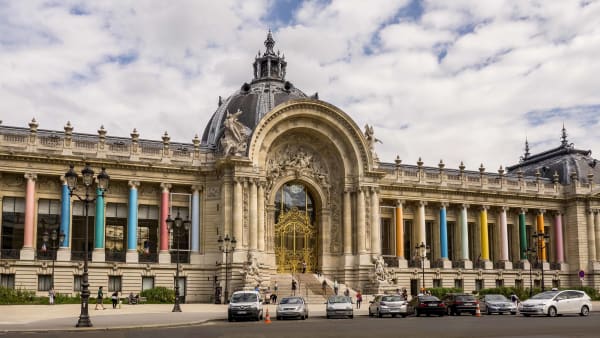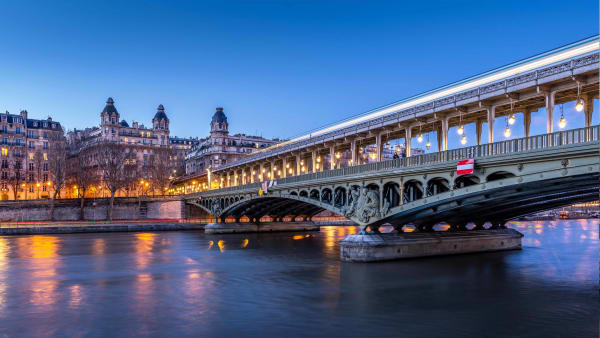Metro in Paris
With its 16 lines, Paris’ Métropolitain covers about 140 miles in the city and more than 300 stops. That plus affordable tickets and it’s no wonder the Métro is one of the most popular means of transport.
Metro in Paris
With its 16 lines, Paris’ Métropolitain covers about 140 miles in the city and more than 300 stops. That plus affordable tickets and it’s no wonder the Métro is one of the most popular means of transport.
The Paris Métro is one of the most widely used forms of transit in the city. Its network covers the city’s central area thoroughly, and its service is reliable and frequent, so it can take you pretty much anywhere you need in Paris. It also doesn’t hurt that the stations are normally kept clean and are generally safe.
The Métro has 16 lines, numbered 1 to 14 (two of them are secondary lines, 3b and 7b). Each of them is assigned a colour, and the stops are indicated on the street with an M, the word Métro or Métropolitain.
Keep in mind that on a public transport map of Paris, you might see the city being divided into five zones. However, when you’re riding the Métro, these zones are irrelevant. As far as this subway network is concerned, it doesn’t matter if your stop is geographically in Zone 1 or 2, the Métro operates as a single-zone system. The zone distinctions are for RER trains and other means of public transport in Paris.
Is Paris’ Métro safe?
Overall, the Métro in Paris is normally safe. The stations are usually patrolled and well-kept, with surveillance cameras all around. As per usual, you main worry should be pickpockets. Here are some tips to avoid them.
- Pickpocketing is quite common in the Métro, especially during rush hour and at the busiest stations. This is because it’s much easier to go unnoticed when there are a lot of people. You should be the most alert when in a busy carriage.
- The best way to avoid pickpocketing is to make sure you have an eye on your belongings. Never leave your things unattended or on display (wallet in your back pocket, open bag, phone on your lap as you fall asleep on the train, etc.).
- Even if the Métro is normally safe, some of the bigger station with lots of corridors are best avoided late at night, right before closing time. They are Gare du Nord, Stalingrad, Barbès-Rochechouart, and Jaures.
Is Paris’ Métro dirty?
The Métro in Paris generally has a decent cleanliness standard. The stations themselves are cleaned regularly and kept free of garbage as much as possible.
That said, we are still talking about crowded and busy underground stations, so occasional unpleasant smells and poor air quality are to be expected. Of course there are significant differences between stations, depending on how central they are. Trains are clean and efficient for the most part, but again, it depends on how busy it is at the time of your visit.
Tickets & passes
Paris Métro has a variety of tickets available, each apt to different needs. Remember that each of the options named below is valid for the entire Métro network and at least Zone 1 of the RER trains, Paris buses, tramways and the funicular.

Children discounts
| Ticket |
|---|
| Type |
| Zones |
| Valid for |
| Ticket | T+ tickets | Carte Mobilis | Paris Visite | Navigo Découverte |
|---|---|---|---|---|
| Type | Single ticket | One-day travel pass | Multi-day pass | Weekly or monthly pass |
| Zones | Zone 1 | All zones available | All zones available | All zones available |
| Valid for | Métro, RER, buses, tramways, and funicular | Métro, RER, buses, tramways, and funicular | Métro, RER, buses, tramways, and funicular | Métro, RER, buses, tramways, and funicular |
- T+ tickets are your basic one-way single tickets. Once validated on the Mètro, one journey is valid for up to 2 hours, meaning you can change lines as many times as you want. You can buy T+ tickets as singles (€1.90) or in a contactless packet (carnet) of 10 (€14.90). These packets need to be loaded on a Navigo Easy Pass, which you will need to get with a one-time purchase (€2.00). Children between 4 and 9 have reduced fares on the 10 T+ ticket packets (€7.45). If you have doubts about the T+ tickets, you can find more info in our dedicated article.
- The Carte Mobilis is a single-day limitless pass. It comes in different zones availabilities, but the one you’re most likely to use is the Zone 1-2 (central area), which costs €7.50.
- The Paris Visite is a multi-day pass, frequently used by tourists since they also offer discounts on museums and tours. These passes come in different duration options (1, 2, 3, or 5 days) and different zone validities, since they are used not only for the Métro, but also RER trains, buses, tramways and the funicular. If you’re only planning on using the metro, you’ll only need the 1-3 Central Paris zone option. Discounts apply to children aged 4-9. If you want to know more about the Paris Visite pass, you can read our dedicated article.
- Finally, the Navigo Découverte is a weekly or monthly pass with no zone limitations. It requires a separate purchase of the card (€5.00) and costs either €22.80 (weekly) or €75.20 (monthly). The weekly ticket is strictly valid Monday to Sunday, regardless of which day you purchased it. Starting Friday, Navigo Découverte passes for the current week are no longer sold, and you can only buy them for the following week. If you want to learn more about the know more about the Navigo pass, you can read our dedicated article.
Watch out for the type of card
Schedule
As with any other metro network, the closing and opening times vary from one line to the other, and the times are approximate. However, the schedule is normally followed. Remember that on days before national holidays, the closing time is normally delayed to 2:15 am.

| Day |
|---|
| Mon-ThurSun |
| Fri-Sat |
| Day | Opening time | Closing time |
|---|---|---|
| Mon-ThurSun | 5:30 am | 1:15 am |
| Fri-Sat | 5:30 am | 2:15 am |
As for the frequency, it changes greatly between the morning and evening rush hours and the dead hours (especially near closing time).
| Frequency |
|---|
| Highest |
| Lowest |
| Frequency | Estimated waiting time |
|---|---|
| Highest | 2-4 minutes |
| Lowest | 10 minutes |
What is the difference between Métro and RER in Paris?
You might be confused about the differences between the Métro and RER trains of Paris. The difference is all about how the two networks function and what areas they occupy.
The Métro is a transport system born to serve the city centre, therefore it only covers the central Paris area (transport Zone 1) and has several stops in each arrondissement. Meanwhile, RER trains aim to connect the city with the surrounding suburbs. As a result, the RER operates on a larger scale, covering transport Zones 1 through 5.
This means that RER trains make fewer stops in the centre and move from one end of the city to the other in a much shorter time. On the other hand, Métro stations are almost everywhere in the centre, but getting from one area to the other can be slower, due to the increased number of stops.
You can read our dedicated article if you want to learn more about the RER network.
Apps for the Métro in Paris
- The entity that operates the majority of public transport in Paris (including the Métro), the RATP has a route planner on their website.
- Bonjour RATP is the app you can use to navigate all of Paris’ public transport. The app is basically an all-in-one application find your route, consult timetables, maps, get live updates on traffic, disruptions, and strikes. It works across the entire network, including Métro, buses (daytime and nighttime Noctilien), RER trains, tramways, Transilien SNCF, and the Orlyvalas. With Bonjour RATP you can also top up some of your tickets and passes: T+ tickets, Passe Navigo, OrlyBus tickets, and RoissyBus tickets. Download Bonjour RATP for iOSDownload Bonjour RATP for Android
If you want to know more about Bonjour RAPT and other useful apps for Parisian transport, you can check out our dedicated article.














